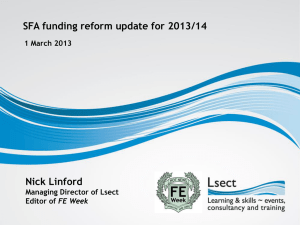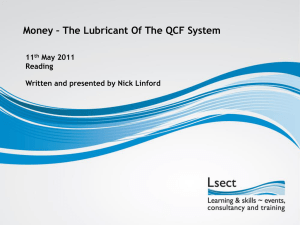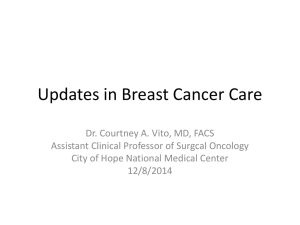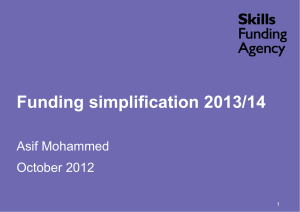SLN/ALND
advertisement
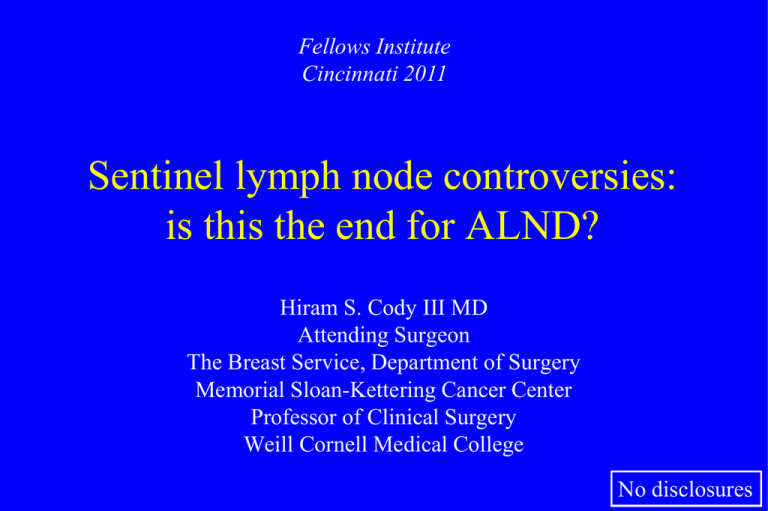
Fellows Institute Cincinnati 2011 Sentinel lymph node controversies: is this the end for ALND? Hiram S. Cody III MD Attending Surgeon The Breast Service, Department of Surgery Memorial Sloan-Kettering Cancer Center Professor of Clinical Surgery Weill Cornell Medical College No disclosures SLN biopsy works SLN 2010 69 validation studies in 8059 patients # pts 8059 SLN found 96% SLN false-neg Accuracy (SLN-/AX+) (SLN correct/total) 7% 97% Kim T et.al. Cancer 2006;106:4-16 SLN 2010 Results of 5 randomized trials Trial # pts SLN found SLN falsenegative Accuracy EIO 532 99% 9% 97% B-32 5611 97% 10% 97% ALMANAC 836 96% 7% 98% GIVOM 749 95% 17% 95% SNAC 1088 94% 5% 98% 61-73% had SLN-only disease NSABP B-32 Clinically Negative Axillary Nodes (n=5,611) Randomization GROUP 2 SLNB GROUP 1 SLNB ALND Will false-negative SLN procedures affect survival? Path. Pos. SLN Path. Neg. SLN ALND No ALND Krag, DN et.al. Lancet Oncology 2010;11:927-33 100 NSABP B-32 OS: SLN negative (8 yr results) 60 40 84.6% received systemic therapy 20 Trt SNR+AD SNR N 1975 2011 Deaths 140 169 HR=1.20 p=0.117 0 % Surviving 80 * 300 deaths triggered the definitive analysis * 309 reported as of 12/31/2009 Data as of December 31, 2009 0 2 4 6 8 Years After Entry Krag, DN et.al. Lancet Oncology 2010;11:927-33 60 40 84.6% received systemic therapy 20 Trt SNR+AD SNR N 1975 2011 Deaths 315 336 HR=1.05 p=0.542 0 % Disease-Free 80 100 NASBP B-32 DFS: SLN negative (8 yr results) Data as of December 31, 2009 0 2 4 Years After Entry 6 8 Krag, DN et.al. Lancet Oncology 2010;11:927-33z Milan/EIO trial: 10 yr results 561 patients 1998-1999 95 mo f/u Veronesi U et.al. Ann Surg 2010;251:595-600 SLN 2010 False-negative = axillary LR # pts # axillary LR (%) median f/u SLN-/no ALND 48 studies* 14,959 0.3% 34 mo median time to axillary LR 20 mo SLN-/no ALND IEO RCT 167 1.2% 95 mo 81 mo SLN+/no ALND 6 studies 583 0.5% 31 mo 22 mo *all with >3 yrs followup Van der Ploeg IMC et.al. EJSO 2008:34:1277-84 We’ve asked and answered the easiest questions SLN 2010 Where have we come and what’s next? • definition • case selection • technique – nuclear medicine – surgery – pathology • non-axillary SLN? • SLN and neoadjuvant? • SLN micromets? • results – morbidity – local control – survival • SLN+ : ALND? SLN 2010 What is the SLN? 1) a blue node 2) a hot node 3) a palpable node SLN 2010 Case selection • SLN biopsy is indicated in almost every patient with a cN0 invasive breast cancer • for DCIS? – YES, selectively • for inflammatory/locally advanced CA? – NO, outside of clinical trials SLN 2010 Louisville (99 surgeons) method SLN found SLN false-negative single-agent (n=244) 86% 11.8% dual-agent (n=562) 90% 5.8% McMasters et.al.,JCO 2000;18:2560-2566 SLN 2010 Finding the positive SLN (n=255) Dye failure Dye success Isotope failure --- 11% Isotope success 11% 78% Cody HS et.al. Ann Surg Oncol 2001;8:13-19 SLN 2010 Declining marginal benefit of dye (finding the positive SLN) 100% 80% 60% 40% 20% 0% isotope success dye-only success 1-500 501-1000 1001-1500 1501-2000 88% 12% 90% 10% 96% 4% 98% 2% Derossis et.al.JACS 2001;193:473-8 SLN 2010 Learning curve: ALMANAC 35 30 25 % 20 False negatives 15 Failed localisations 10 5 0 1 2 to 10 11 to 20 21 to 30 31 to 40 Most failed and false-neg results occurred in the first procedure! Clarke DH. Ann Surg Oncol 2004;11:211S-15S SLN 2010 Morbidity: early reports Lymphedema rates SLNB ALND 7 case series 2000-2005 (n=1903) 5% (0-13%) 29% (7-77%) SLN 2010 Z0010 morbidity • prospective observational study of SLN biopsy • >5500 patients accrued 1999-2003 • at 6 months – 8.6% axillary paresthesias (>90% mild) – 3.8% decreased upper extremity ROM – 6.9% lymphedema (>2 cm over non-operated side) • lymphedema was predicted by – increased BMI (p=0.0005) – increased age (p=0.04) Wilke LG et.al. Ann Surg Oncol (suppl) 2005;12:S27 SLN 2010 MSKCC morbidity Lymphedema at 5 yrs SLNB alone n=600 SLNB/ALND n=336 Subjective 3% 27% p<0.0001 Measured (>2 cm change) 5% 16% p<0.0001 McLaughlin SA et.al. JCO 2008:26:5213-26 SLN 2010 MKCC sensory morbidity p < 0.001 Temple LK, Ann Surg Oncol 2002;9:654-62 There are still some areas of debate SLN 2010 Non-axillary SLN: what to do? SLN 2010 Internal mammary experience Author IMN imaged IMN found IMN positive IMN-only positive Van der Ent/2001 n=256 25% 16% 4% 1.2% Estourgie/2003 n=691 22% 19% 3% 1.3% Farrus/2004 n=120 17% 12% 1.6% 0 Leidenius/2006 n=984 14% 11% 1.8% 0.8% Madsen//2007 n=506 22% 17% 4% 1% Heuts/2009 n=1008 20% 14% 3% 0.9% SLN 2010 Reoperative SLN biopsy Non-axillary drainage on preoperative lymphoscintigram “First time” SLN biopsy Reoperative SLN biopsy 6% (313/5482) 30% (19/63) p<0.0001 Port ER et.al. Ann Surg Onc 2007;8:2209-14 SLN 2010 SLN is better after neoadjuvant (my bias) • fewer operations • false-negative rate is probably not increased • avoidance of ALND for patients with pathologic CR • ACOSOG 1071 (PI J Boughey) Sentinel node SLN before vs after chemo: cN0 MDACC 1994-2007 T1-3, cN0 n=3746 SLN found SLN false-negative SLN before chemo n=3171 98.7% 4.2% (23/542) SLN after chemo n=575 97.4% 5.9% (5/84) (p=0.017) (p=0.48) Hunt KK et.al. Ann Surg 2009 epub. SLN 2010 Intraoperative assessment 100 90 80 70 sensitivity: 60 method+/SLN+ 50 40 (%) 30 20 10 0 frozen touch prep smear All cases <=2 mm >2 mm Size of nodal metastasis Brogi E et.al. Ann Surg Oncol 2005;12:173-80 SLN 2010 EIO study (RT-PCR) • 293 SLN in 293 pts • frozen section of entire SLN – 50m intervals – H&E (IHC selectively) – 118 sections (40-258)/SLN • intervening tissue – half for RT-PCR – half discarded Viale G et.al. Ann Surg 2008;247:136-42 SLN 2010 Frozen vs RT-PCR 100 90 80 70 sensitivity: 60 method+/SLN+ 50 40 (%) 30 20 10 0 frozen RT-PCR All cases <=2 mm >2 mm Size of nodal metastasis Brogi E et.al. Ann Surg Oncol 2005;12:173-80 Viale G et.al. Ann Surg 2008;247:136-42 SLN 2010 MSKCC pathology protocol H&E and IHC 50m H&E and IHC 1 H&E and 1 IHC (cytokeratin AE1:AE3) stained section from each of two levels 50m apart Tan LK et.al. J Clin Oncol 2008; 26: 1803-9 P r o p t i n D s e a F r 0. 0.2 0.4 0.6 0.8 1.0 MSKCC micromet studyeas D is by Sta 0 DFS by method of staining p<0.001 H&E-/IHCIHC+ H&E+ H &E, + IH C + H &E, + IH C H &E, IH C 5 1 0 1 5 2 0 2 5 T im e ( Tan LK et.al. JCO 2008;Ye 26: 1803-9 MSKCC micromet study DFS by size of metastasis pN0 (negative) pN0i+ (<0.2 mm) pN1mi (0.3-2.0 mm) p<0.001 Tan LK et.al. JCO 2008;26:1803 Netherlands micromet study DFS by size of metastasis N0 vs N0i+ or N1mi N0 vs N0i+, N0 vs N1mi p<0.001 p<0.002 p<0.001 de Boer M et.al. NEJM 2009;361:653-63 www.mskcc.org/nomograms Van Zee KJ. Ann Surg Oncol 2003;10:1140-51 Predicting non-SLN metastases SLN+ (all pts) SLN+ (mets <2 mm) A comparison of 9 models by AUC curves Coutant C et.al. JCO 2009;27:2800-08 SLN 2010 Selective ALND for SLN+ 1960 patients with positive SLN Nomogram score (median predicted likelihood of residual axillary disease) Axillary local recurrence ( at 26 mo) SLN+/no ALND (n=315) 15% of SLN+ 10% 1.9% SLN+/ALND (n=1645) 85% of SLN+ 37% 0.36% p=0.004 Park J et.al. Ann Surg 2007;245:462-8 SLN 2010 Selective ALND for IHC+ SLN Nomogram score (predicted odds of non-SLN disease) Axillary local recurrence ( at 6.4 yrs) SLN+/no ALND (n=76) 44% of SLN+ 4.2% 0% (63% chemo, 5% ax RT) SLN+/ALND (n=95) 56% of SLN+ 8.1% 0% (88% chemo, 2% ax RT) 171 patients with IHC+ SLN Pugliese MS. Ann Surg Oncol 2010;17:1063-68 SLN 2010 Fewer ALND for SLN+ (FS negative or not done) 80 75 p<0.001 70 % ALND 65 for SLN+ 60 55 50 1997 1998 1999 2000 2001 2002 2003 2004 Year Park J et.al. Ann Surg 2007;245:462-8 SLN 2010 Patterns of ALND (NCDB) 23% no ALND 55% no ALND Bilomoria KY et.al. JCO 2009;27:2946-53 SLN 2010 Trends in ALND for SLN+ (NCDB) SLN+ and no ALND % Bilomoria KY et.al. JCO 2009;27:2946-53 SLN 2010 Outcome +/- ALND (NCDB) Axillary local recurrence 5 yr relative survival SLN micrometastases (<2 mm) SLN only 0.4% (n=802) SLN/ALND 0.2% (n=2357) SLN macrometastases (>2 mm) SLN only 1.0% (n=5596) SLN/ALND 1.1% (n=22591) 99% 98% 90% 89% Bilomoria KY et.al. JCO 2009;27:2946-53 2010 annus mirabilis! 1) micromets on IHC? 2) micromets on H&E? 3) ALND for SLN+? ACOSOG Z0010-Z0011 Z0010 cN0 and BCT SLN biopsy Bone marrow aspiration SLN+ Z0011 randomize to ALND clinician/patient blinded to IHC and bone marrow SLNObserve Observe suspended 12/04 at n=889 due to slow accrual and too few events www.acosog.org Z0010 trial Survival by staining method Method H&E negative H&E positive IHC negative IHC positive (3945/5184) (1239/5184) (3595) (350) 5 year survival 95.6% 92.8% 95.8% 95.1% (95% CI) (95.0-96.3) (91.3-94.3) p=0.0002 (95.0-96.5) (92.7-97.5) p=0.53 Cote R et.al. ASCO 2010 NSABP B-32 Clinically Negative Axillary Nodes (n=5,611) Randomization GROUP 2 SLNB * GROUP 1 SLNB* ALND A combined 1390 pts had H&E+ SLNs with f/u in 1389 pts Path. Pos. SLN Path. Neg. SLN ALND No ALND Julian TB et.al. SABCS 2010 NSABP Protocol B-32 1390 pts with H&E+ SLN Variable size of metastasis Category # pts micro (0.2-2 mm) 312 macro (>2 mm) 422 Unknown 626 Julian TB et.al. SABCS 2010 NSABP B-32 DFS by SLN status on H&E 100 % Disease free 80 60 40 Patients Neg SN Pos SN (Micromets) Pos SN (Macromets) 20 HR* (95% CI) P-value* 0.998 (0.765-1.302) 1.783 (1.480-2.150) 0.99 <0.001 0 0 1 2 3 4 5 Years after Randomization * HR (95% CI) & p-value comparison with Neg SN 6 7 Julian TB et.al. SABCS 2010 8 NSABP B-32 OS by SLN status on H&E 100 % Alive 80 60 40 Patients Neg SN Pos SN (Micromets) Pos SN (Macromets) 20 HR* (95% CI) P-value* 0.788 (0.518-1.199) 2.387 (1.891-3.013) 0.27 <0.001 0 0 1 2 3 4 5 Years after Randomization * HR (95% CI) & p-value comparison with Neg SN 6 7 Julian TB et.al. SABCS 2010 8 NSABP B-32 IHC study • 5611 accrued • 3989 (71%) pN0 by H&E – 2 mm slices – routine IHC prohibited • 3887 (97%) path • 3884 (99.9%) follow up • 95 mo median f/u • IHC sections at UVM – 0.5 and 1.0 mm deeper • 15.9% IHC+ – 11.1% ITC (N0i+) – 4.4% micromets (N1mi) – 0.4% macromets (N1) Weaver DL et.al. NEJM 2011; epub 1/19/11 NSABP B-32 Survival by IHC status 5 year survival IHC negative n=3268 IHC positive n=616 p OS 95.8% 94.6% 0.03 DFS 89.2% 86.4% 0.02 DDFS 92.5 89.7% 0.04 Weaver DL et.al. NEJM 2011; epub 1/19/11 NSABP B-32 Multivariate hazard ratios Variable Death Any event Distant disease IHC (+ vs -) 1.40 1.31 1.30 p=0.02 p=0.009 p=0.03 0.53 0.60 0.68 p<0.001 p<0.001 p=0.001 1.32 1.41 1.42 p=0.06 p<0.001 p=0.01 Hormonal rx (+ vs -) T size (T2-3 vs T1) Weaver DL et.al. NEJM 2011; epub 1/19/11 NSABP B-32 Site of first treatment failure First treatment Failure IHC-negative IHC-positive Local All patients n=3268 2.6% no ALND n=1660 2.6% All patients n=616 2.6% no ALND n=300 1.3% Regional 0.4% 0.5% 1.1% 1.7% Distant 2.9% 3.2% 3.7% 3.3% Weaver DL et.al. NEJM 2011; epub 1/19/11 SLN 2010 Are we asking the wrong question? We’ve been asking We should be asking • “which SLN+ patients don’t need ALND?” • “do any SLN+ patients need ALND?” SLN 2010 Z0010-Z0011 trials (ACOSOG) Z0010 cN0 and BCT SLN biopsy Bone marrow aspiration SLN+ Z0011 randomize to ALND clinician/patient blinded to IHC and bone marrow SLNObserve Observe suspended 12/04 at n=889 due to slow accrual and too few events www.acosog.org SLN 2010 Z0011 schema Giuliano AE et.al. Ann Surg 2010;252:439 SLN 2010 Z0011 eligibility Eligible Ineligible • clinical T1-2N0 breast cancer • Nodal RT • H&E-detected SLN metastases • IHC-detected SLN metastases • lumpectomy + whole breast RT • Matted nodes • adjuvant systemic therapy by choice • 3 or more involved SN Giuliano AE et.al. Ann Surg 2010;252:439 SLN 2010 Z0011 systemic therapy Systemic therapy SLN+/ALND SLN+/no ALND chemo 58% 58% hormonal 46% 47% chemo and/or hormonal 96% 97% Giuliano AE et.al. Ann Surg 2010;252:439 SLN 2010 Z0011 locoregional recurrence Recurrence @ 6.3 yrs median follow-up SLN+ ALND (n=388) SLN+ no ALND (n=425) local 3.6% 1.9% regional node 0.5% 0.9% local+regional 4.1% 2.8% p=0.47 Additional positive nodes in 27% of ALND’s Giuliano AE et.al. Ann Surg 2010;252:439 SLN 2010 Z0011 overall survival Giuliano AE et.al. JAMA 2011;305:569-75 SLN 2010 Z0011 survival Survival @ 6.3 yrs median follow-up SLN+ ALND (n=388) SLN+ no ALND (n=425) DFS 82.2% 83.8% OS 91.9% 92.5% Giuliano AE et.al. ASCO 2010 SLN 2010 Z0011 overall survival • HR boundary for noninferiority = 1.3 • unadjusted HR 0.79 – 0.56-1.10 • adjusted HR 0.87 – 0.62-1.23 – adjusted for age, ER Giuliano AE et.al. JAMA 2011;305:569-75 SLN 2010 AMAROS trial: first 2000 patients Straver ME et.al. JCO 2010; 28:731-7 SLN 2010 AMAROS adjuvant rx SLN+ ALND n=300 SLN+ Axillary RT n=266 endocrine rx 32% 30% chemo rx 35% 39% chemo+endocrine rx 47% 46% breast/chest wall RT 86% 89% Straver ME et.al. JCO 2010; 28:731-7 SLN 2010 Conclusions • SLN metastases detected only by IHC are of marginal significance • this has significant implications for – – – – pathologists surgeons medical oncologists patients! • should IHC staining of SLN be abandoned? SLN 2010 Conclusions • in the absence of extensive axillary disease, SLN+ patients having BCT/ RT may not need ALND • this has significant implications for • • • • preop axillary staging by ultrasound and FNA: unnecessary? intraoperative SLN assessment by pathology: irrelevant? prediction of non-SLN status by nomograms: obsolete? return to OR for ALND: historical interest only? SLN 2010 ALND: the end of an era? • IF ALND for SLN+ patients – does not change systemic therapy – does not reduce local recurrence – does not improve survival • THEN ALND for SLN+ patients should be done – to salvage local recurrence (a rare event) – not to prevent it SLN 2008 MINDACT trial EORTC 10041 (BIG 3-04) T1-3N0 breast cancer n = 6000 Low/Low risk hormonal RCT Discordant risk (low/high or high/low) Rx based on 70 gene profile 1) 70 gene profile 2) Adjuvant! Online High/High risk chemo RCT +/- hormonal RCT Rx based on Adjuvant! Online www.mindact.org
